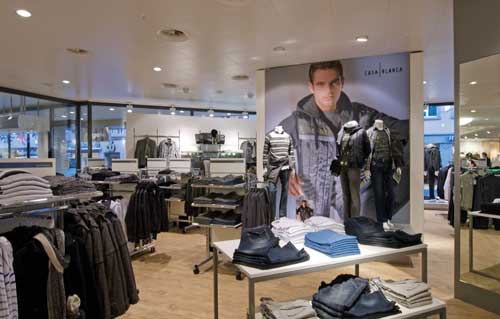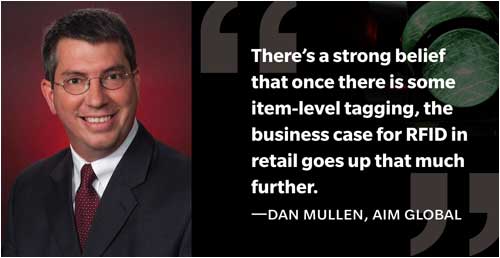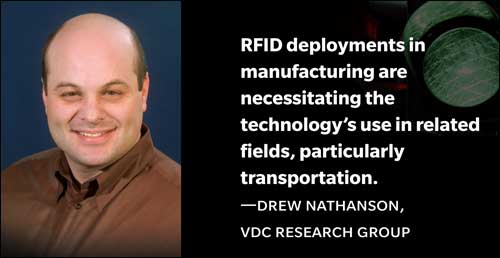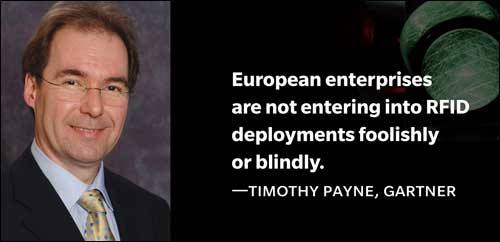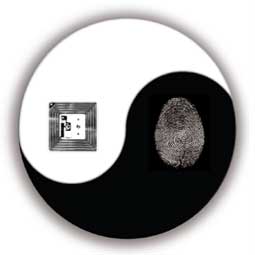A palpable shift in the way European companies and organizations view radio frequency identification can be felt across the continent. Once considered just a promising technology, RFID is now recognized as a viable solution to real-world business problems. After several years of trials and small-scale deployments, RFID has proved its mettle. Early adopters in government and a wide range of industries—retail, manufacturing, transportation, and entertainment and leisure—are forging ahead with full-on deployments. And with trial results pouring in, potential adopters are now fully aware of RFID’s ability to track and monitor an endless variety of products and assets. They’re scrutinizing the research and deciding where and how it makes sense to deploy RFID.
Europe’s comfort zone with RFID is rooted in the slow, steady and practical approach companies took to learning about the technology, acquiring skills and building on the knowledge. “What we’re seeing in terms of the evolution of the market is that companies are not looking for a technology and then finding something to do with it,” says Tim Payne, a research director and RFID industry analyst at Gartner, a technology research firm in Stamford, Conn. “They’re looking for solutions to problems. If an RFID-based solution to their problem is the best one, then they’ll go for that.”
To get a clear picture of RFID in Europe, it’s best to take a series of snapshots rather than a single landscape image, says Drew Nathanson, an RFID analyst for the VDC Research Group in Natick, Mass. RFID opportunities and applications vary greatly across industries, hinging on the specific needs of each market, he observes. Yet there are certain bottom-line issues that drive the RFID business case across all industries. “What it comes down to is this: Is there really an ROI and are the benefits really there?” Nathanson says. “Is the solution living up to the expectations that were set by the supplier to the end user? Is it something where it justifies going forward with the investment?”
While the pace of RFID deployments has slowed in recent months due to an historically deep economic slump, many observers expect the technology’s march forward to resume quickly as enterprises pinpoint more ways of turning RFID innovations into productive solutions. “The overall economic downturn has hit the market, but it’s not a contraction,” Nathanson says. “End users in the European region seem to not be decreasing their IT spending on RFID as much as they are here in the States.”
Government
Worldwide, national, regional and local governments are employing RFID technologies to address an array of pressing concerns intelligently and efficiently. But the European Union has taken a particular interest in sponsoring research to put Europe in the “RFID fast lane” while simultaneously protecting citizens’ identities and privacy. In addition to serving as an R&D incubator, government is a major RFID adopter, with applications running the gamut from border security to mail management, public utility maintenance and community services.
With the public sector more enmeshed in daily life in European countries than in the United States, national governments within the E.U. see RFID-enabled passports and other identity documents as a powerful way to enhance border security and provide more efficient access to government services, including health care. Austria, France and Germany are among the countries adopting smart cards for citizen IDs. At Portugal’s international airports and seaports, RFID infrastructures designed to read electronic passports, which include embedded RFID chips, now also help speed travelers through border-control lines. “Europe is really paving the way there,” Nathanson says. “They’re looking at it with a much broader vision.”
Government-operated public services, including transport and libraries, are also on the RFID forefront. “Libraries are one of the bright spots in the industry,” Nathanson says.
Health care would seem like a natural hot spot for government-sponsored RFID applications in Europe, yet widespread adoption is still likely years away. “Uptake for RFID in health care is stronger in the U.S. at present,” says Michael J. Liard, an RFID analyst at ABI Research in Oyster Bay, N.Y. “While there is some traction for RFID-enabled health-care solutions, strong privacy concerns, education and other adoption challenges remain.”
RFID as a pharmaceutical identification and tracking tool, while increasingly popular in the United States, so far has had little impact in Europe. “In Europe, the support for using RFID against drug counterfeiting remains small,” Liard says. “The industry is clearly pushing the mass serialization of drugs, but it appears to support the 2-D bar code as the preferred identification technology.” The motivation is primarily financial, Laird notes. “The 2-D bar code can be printed on the packaging, and costs are lower than for RFID tags.”
Yet there are signs that interest in RFID is picking up among European health-care providers in at least one area. “The National Health Service in the U.K. [has] standardized on GS1 standards for item identification,” says David Lyon, EPCglobal‘s business manager for GS1 UK, the London-based not-for-profit supply-chain standards organization. “The thing that’s been branded the ‘killer app’ for RFID is asset tracking, particularly within the Health Service. We did a study with The Nursing Times magazine looking at the way nurses spend time. Across 1,000 nurses, we found that 25 percent of a nurse’s time is spent looking for things.”
Retail
Many industry analysts point to retail as the European industry that has embraced RFID most enthusiastically. In fact, several European retailers—including Marks & Spencer in the United Kingdom, the Metro Group in Germany and the Charles Vögele Group in Switzerland—are widely recognized as global RFID leaders. “Some of the European retailers are a little further ahead [of the United States] in the things they’re doing with RFID,” says Gartner’s Payne. European retailers adopting RFID are generally dedicated to smoothing out revenue-robbing bottlenecks both within their supply chain and inside their own operations. “Where they’ve got inefficient or ill-disciplined processes, that tends to be where they’re focusing,” Payne says.
The Metro Group has perhaps the most extensive RFID infrastructure in global retailing. The German retailer is RFID-tagging all pallets shipped to its supermarkets and wholesale food stores in Germany, as well as working with DHL to track the movement of pallets to about 90 stores in France. By using enterprisewide RFID to provide real-time visibility, the Metro Group is increasing the efficiency of its supply chain with the aim of improving the customer shopping experience. “We are convinced that innovative technologies are the key to advancing our business,” says Gerd Wolfram, Metro Group‘s managing director of information technology. “Today, at around 400 locations throughout Europe, [RFID] is being employed to accelerate incoming and outgoing goods processes. Around 3 million RFID-tagged pallets are processed and delivered every year.”
Europe’s retail community is also breaking new ground in item-level tracking. European fashion retailers—including NP Collection in Finland, Karstadt and Krause Outlet, both in Germany, Taracci in Sweden and Throttleman in Portugal—have deployed RFID solutions at the item level to improve efficiencies. But the Charles Vögele Group, 2009 RFID Journal Award winner for Best RFID Implementation, is clearly leading the pack. The Swiss fashion retailer is moving forward with its RFID deployment in a variety of areas. The company, which has already RFID-tagged more than 380,000 items, tracks individual garments as they move around the world—from suppliers to distribution points to individual retail outlets. At the store level, it uses RFID to track the entrance and departure of goods, manage replenishment, record which items are brought out from stock and onto the sales floor, and support point-of-sale transactions. Item-level information facilitates better information and process development across the entire supply chain, according to Thomas Beckmann, VP of group supply-chain management, providing a base for competitive advantage.
“There’s a strong belief that once there is some item-level tagging, the business case for RFID in retail goes up that much further,” says Dan Mullen, president of AIM Global, trade association for the automatic identification and data capture industry, in Warrendale, Pa. “Europe seems to be moving a little more quickly here than we are.”
Most European retailers that have adopted RFID work proactively with vendors to understand the technology, Mullen says. “But at a systems level, they’re also asking, ‘OK, what does this mean to the business process, the customer interaction and the different ways we provide value?’ That’s what’s helping to make them leaders.”
Manufacturing
As in other places around the world, European manufacturers are turning to RFID to take advantage of the tracking, insight and monitoring efficiencies the technology provides. “We largely think about the U.S. and the Asia-Pacific region in terms of manufacturing,” says ABI’s Liard, “but it’s also happening in Europe, for aviation and automobile manufacturing in particular.”
Germany’s ZF Friedrichshafen, manufacturer of automotive transmissions and chassis, uses RFID to improve the maintenance of motors that run the production machinery at its factory in Saarbruecken. BMW employs a real-time location system (RTLS) at its assembly plant in Regensburg, Germany, to match the cars being assembled with the tools needed to perform the job. Caterpillar also adopted an RTLS, at its heavy-equipment manufacturing plant in Belgium, to ensure its hydraulic valves and hoses are assembled properly.
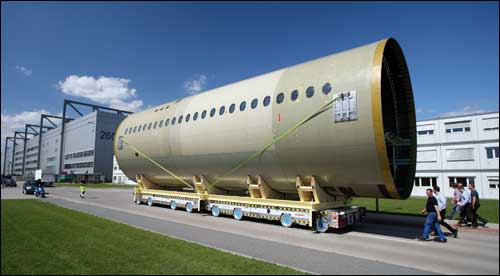
Airbus, one of Europe’s largest manufacturers, has been one of the continent’s most enthusiastic RFID adopters and innovators. Four years ago, the aerospace giant took a systematic, holistic approach to RFID, under the direction of a 10-member RFID steering committee, and began a three-stage RFID implementation. Today Airbus, RFID Journal’s 2008 Award winner for Best RFID Implementation, is gaining large-scale visibility into its business and production processes. Citing “competitive reasons,” Carlo K. Nizam, head of value-chain visibility and RFID, declines to put a dollar or euro estimate on the return on investment from Airbus’ RFID prgram, but he estimates the savings as “in the order of millions” of euros. Airbus is also paving the way for suppliers, customers and other stakeholders to adopt RFID.
Transportation and Logistics
RFID deployments in manufacturing are necessitating the technology’s use in related fields, particularly transportation, according to VDC’s Nathanson. “As manufacturing comes up to speed, the transportation infrastructure to support that manufacturing has to come up in place as well,” he says. RFID gives transportation and logistics operations the efficiency and visibility they need to support rising manufacturing output, he notes.
When it comes to the transportation and logistics sector, RFID deployment has unfolded differently in Europe than in the United States, according to Gartner’s Payne. “In the U.S., you get RFID yard management—having a lot of trailers sitting around in very big distribution yards,” he says. “There isn’t as much call for that over in Europe because there really isn’t the space in a lot of places to have those very big yards.” Consequently, Payne notes, RFID in European transportation and logistics is generally more focused on vehicle scheduling, including the tracking of departures, arrivals and en route times.
It’s third-party logistics providers (3PLs) that are driving RFID adoption in European freight transport. “There is a lot more outsourcing of transportation in Europe than you get in the U.S.,” Payne says. “Typically, if you outsource in Europe, you use the 3PL’s warehousing and transportation infrastructure, so customers are really pushing for 3PLs to install RFID throughout their network so they can get visibility, so they can track the goods and see what is happening.”
While 3PLs may be the driving force behind Europe’s RFID transportation sector, individual carriers and businesses that manage their own transportation needs also are starting to invest in RFID. TNT Innight, a package delivery service with a Europewide distribution network, is using RFID in a limited deployment to track some 1,500 parcel carrier totes used by its All Night Express Services. The solution helps ensure the totes are delivered to customers on time and provides proof of delivery.
“For me, it is important that there is a customer business case for using RFID technology,” says Nico Bossenbroek, information and communications services manager for TNT Innight, based in Nieuwegein, The Netherlands. “If there is a positive business case, then TNT Innight has the business case for investments in the infrastructure. We do not look first at the possibilities of RFID in our internal sorting and distribution process—the voice of our customer is the most important thing.”
Entertainment and Leisure
From its initial use as a way for ski resorts to organize lift lines, RFID has branched out into a wide array of entertainment and leisure applications. In recreation-minded Europe, the technology now helps theme park operators, sports teams and other public event enterprises control venue access, register guests and participants, manage event timing and minimize ticket fraud. For RFID adopters, the goal is twofold: to cut costs and enhance the customer’s experience.
For the past four years, The Southend United Football Club in Essex, England, has incorporated RFID technology into its season tickets. Geoffrey King, chief executive of the “Shrimpers,” says the tickets, which include an embedded RFID chip, have helped reduce inconvenient and potentially dangerous bottlenecks at the stadium’s entrance gates. “We have a tumbling bar [entrance] system, and as you approach it with an RFID card, this thing will turn—as soon as you touch it—and let you in.”
RFID-based ticketing also helps the team combat fraud. “For example, an adult would go and buy a student ticket, or even a child’s ticket, and would attempt to—and often did—get in without being challenged, because we were relying upon the human element to read the ticket carefully,” King says. “Now, with an RFID card…the system warns us that a concessionary ticket holder is trying to get in, and that gives us an opportunity to look at the individual to make sure that he is of the right age or the right category.”
The European Olympic Youth Festival, held last July in Tampere, Finland, also used RFID for guest management. Event attendees were issued RFID tag-based ID passes, which allowed them to enter accommodations, dining areas and competition venues. The passes also gave holders free access to the local public transportation system. “The project went exactly as we planned,” says Mikko Heinonen, festival project manager. “Access control was easier.”
Even the sport of kings now benefits from RFID. TurfTrax, in Salisbury, England, has developed and patented a transportable RFID-based tracking system that enables the collection and broadcast of real-time speed and positional data of horses during races. The data is used by the horse racing, betting and media industries. Organizers of foot races also take advantage of RFID, to register and time runners, Liard notes. “There are more marathons that happen in Europe than happen in the U.S.,” he says.
A Bright Future
Most analysts see an unlimited future for RFID in Europe, with providers and adopters both eagerly pushing the technology’s boundaries outward. The Metro Group, for example, commissioned Avery Dennison to develop an EPC ultrahigh-frequency tag that would improve performance, and the retailer now achieves nearly 100 percent read rates, even on pallets loaded with products containing liquid or packaged in metal.
“We’re seeing a lot of innovation from the supplier side, trying to meet the expanding demands on the end-user side,” says VDC’s Nathanson. “We’re also seeing end users that have a much deeper understanding of the technology as well as an increased comfort level.” Contactless smart-card technology, for example, is being adopted in Europe much faster than elsewhere, he notes. “In this, we look upon Europe as a pioneering region.”
European enterprises are not entering into RFID deployments foolishly or blindly, according to Gartner’s Payne. “They’re expecting to see, from vendors and technology providers, more complete solutions,” he says. “They are fed up with having to go somewhere for tags and somewhere else for readers and somewhere else for middleware and then find someone to pull it all together.” European enterprises want solutions that are proven and standardized—”[not] something that needs to be fiddled about with and customized.” Governments, in particular, Payne adds, prefer a single partner that can guarantee security and privacy on a complete, seamlessly integrated system.
European enterprises’ exacting design and implementation requirements are leading to carefully crafted RFID deployments that serve, in many respects, as models for the rest of the world, according to Nathanson. “They’re a couple of steps ahead of [the United States] in…thinking about things, and finding a way to get more value out of a solution,” he says. “It should trickle over here very quickly, but for now it’s one of those things where they’re definitely ahead of the game.” Nathanson points to Charles Vögele as a company that’s taking a uniquely European approach to RFID. “They’re tagging at the manufacturing stage all the way through to the point of sale,” he says. “It’s a complete—a holistic—approach to RFID.”
“I think Europe tends to be very positive about RFID overall,” says AIM’s Mullen, noting he’s impressed by the optimism and enthusiasm he sees from both adopters and vendors. “Countries like the U.K., Germany and Scandinavia have always been, and will continue to be, fairly proactive in adoption of new technology to try to gain an advantage—and my guess is that they’ll probably lead the [economic] uptick.”
BRIDGE to Somewhere
Unlike the United States, which only dabbles in government-private RFID partnerships, Europe has focused on creating joint ventures to build a strong, continentwide RFID competence, and to bring the technology’s benefits to a range of people and companies. Most such projects have been funded by the European Union’s executive branch, the European Commission.
The largest and most important EC-funded RFID venture is BRIDGE (Building Radio Frequency Identification Solutions for the Global Environment), which was set up in 2006 to help enterprises surmount barriers preventing implementation of the EPCglobal network in Europe. BRIDGE is scheduled to wind down this year. As the project concludes, some observers are asking if it was worth the effort.
Henri Barthel, director of global partnerships and projects for Brussels-based GS1 Global, and BRIDGE coordinator, says the project was created with the idea of getting Europe into the RFID fast lane. He feels this goal has been met, though he regrets that BRIDGE wasn’t able to generate at least one major game-changing RIFD technology. “I’m not disappointed, but I was sort of secretly hoping that after three years we would have a real breakthrough,” he says. “This hasn’t happened yet; however, all these things take time.”
Critics contend that government-sponsored projects like BRIDGE deliver precious little in the way of real-world RFID deployments. “It gets the message out, and it’s a great way to keep…the development and the innovation levels going,” says Drew Nathanson, an RFID analyst for the VDC Research Group. “[But] if they don’t really carry through, or these projects don’t amount to anything, it’s just kind of shooting blanks—you’re making a lot of noise, but you’re not doing anything.”
Supporters counter that BRIDGE, which united major potential adopters with RFID innovators at universities and elsewhere, was designed to open a dialog and spur the development of new RFID technologies and methodologies, not to deliver immediate real-world results. Michael J. Liard, an RFID analyst at ABI Research, feels it’s unfair to judge BRIDGE on a track record covering only a few years. “I think the key takeaway on this…is we need more initiatives and programs like [BRIDGE] that can bring together independent perspectives into a collaborative environment.”
Barthel defends BRIDGE and its record. “We may be seen as having less success in some areas than others,” he says, “but there were also a number of areas where we issued new initiatives or new proposals that were not even thought about at the start of the project.” BRIDGE attracted the participation of many major corporations, Barthel notes, including giants such as Sony and Carrefour, France’s largest retailer. “I’m sure they have long-term plans of doing something,” he says, “and BRIDGE was maybe a help to streamline some of these initiatives.”
Tim Payne, a research director and RFID industry analyst at Gartner, feels that government-sponsored projects can play a major role in RFID evolution and adoption, even if definitive results aren’t immediately forthcoming. They constitute “a very important part of building up the confidence, building up the knowledge base around where you can use RFID,” he says.
Europe Strikes a Privacy Balance
As RFID sweeps across Europe, privacy remains a concern. In May, the European Commission, the European Union’s executive branch, called on member states to work to ensure privacy and security controls are built into RFID systems.
A draft proposal issued by the E.C. outlined basic principles for protecting consumers’ privacy and personal data. If enacted, the recommendations would be the world’s most stringent RFID privacy safeguards. They state:
• When consumers buy products with RFID, the items should be deactivated free of charge at the point of sale, unless the consumer explicitly opts in. Exceptions can be granted to avoid unnecessary burden on retailers, for example, but only after an assessment of the technology’s impact on privacy.
• Companies or public authorities using RFID should give consumers clear and simple information so they understand if their personal data will be used, the type of data (such as name, address or date of birth) and for what purpose.
• To promote consumer awareness, companies should use a common European sign to identify RFID-tagged products.
The European Consumers’ Organization was pleased with the recommendations. RFID industry organizations also welcomed them, saying the document paves the way for greater implementation of RFID technology. They believe it provides guidance and flexibility to develop and deploy business applications.
The recommendations are merely the start of an information-gathering process that will go on for the next few years, according to Michael J. Liard, an RFID analyst at ABI Research. Everyone from national trade representatives to RFID industry organizations and consumers will have the opportunity to voice their opinions.

